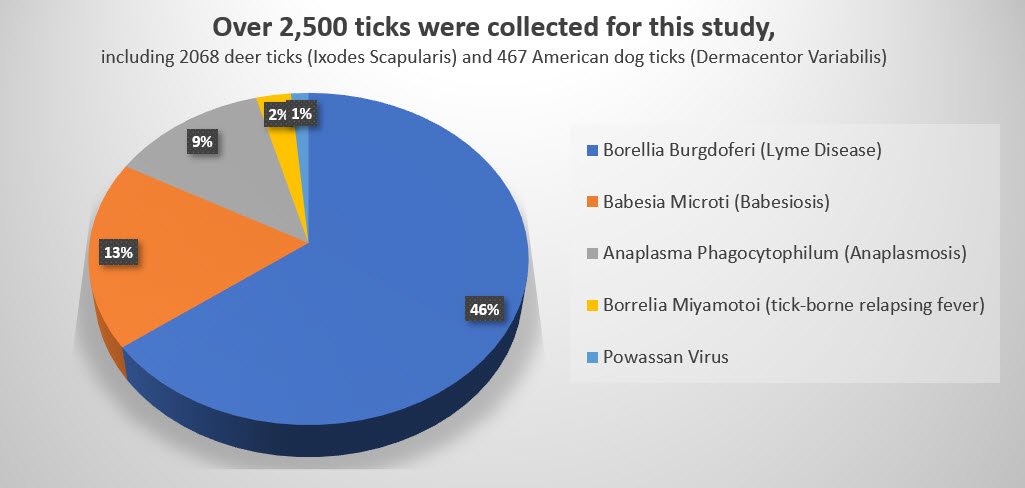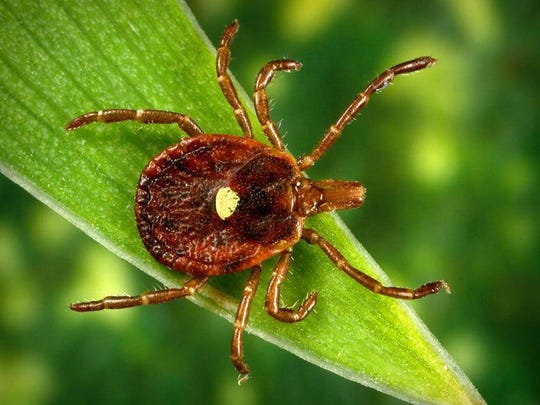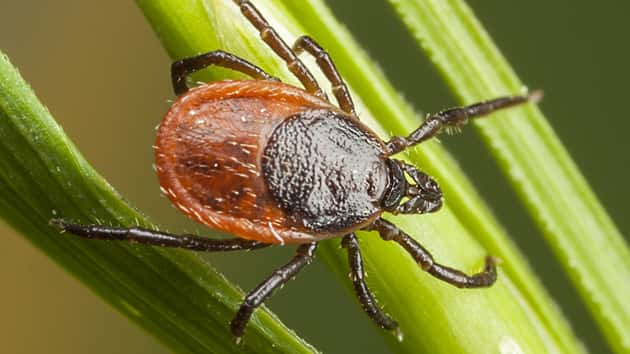Another Warm Winter Means More Ticks With An Increase In Tick Species As Well In Connecticut Highlight How Lyme and Tick-borne Diseases Are Spreading in 2023
CAES (Connecticut Agricurltural Experiment Station) CT Tick Report
Spring is almost upon us, which in Connecticut means sunshine, warmer, longer days, and unfortunately, ticks. Data from the Connecticut Agricultural Experiment Station (CAES), released in last year's report, with funding from the Centers for Disease Control and Prevention (CDC), indicates that 2019 was a particularly bad year for ticks across the state.
Alarming Data From A Bad Tick Season Starting In 2021
Over 2,500 ticks, including 2068 deer ticks (Ixodes Scapularis) and 467 American dog ticks (Dermacentor Variabilis) were collected, and all-female deer tick samples were tested for several pathogens that cause disease in humans. The results were alarming, and experts warn that a mild winter can contribute to a larger boom in the tick population, so 2020 - 2021 could potentially be a more active year for the tick population.
46% of 2 Different Tick Species Samples
Carried Lyme Disease
(Ixodes Scapularis & Dermacentor Variablis)

Out of the adult deer and american dog tick samples tested:
- 46% carried Borellia Burgdoferi (Lyme Disease),
- 13% were positive for Babesia Microti (Babesiosis),
- 9% Anaplasma Phagocytophilum (Anaplasmosis),
- 2% Borrelia Miyamotoi (tick-borne relapsing fever)
- 1% Powassan Virus
The CAES did not test for other tick-borne pathogens, such as Babesia Duncani (Babesiosis more common to the Pacific coast and Canada), Bartonella Henselae (cat-scratch disease), and Bartonella Quintana (trench fever).
Perhaps more concerning, two types of ticks found for the first time last year in Connecticut were identified, the lone star tick and Asian longhorned tick.
Lone Star tick (Amblyomma americanum):
 The lone star tick is known for the silvery white star-shaped spot on its back, and is distributed throughout the eastern US. The CDC has identified this tick as a vector for Ehrlichia chaffeensis and E. ewingii (ehrlichiosis), Francisella tularensis (tularemia), Heartland virus, Bourbon virus, and Southern tick-associated rash illness (STARI). Lone star tick can also cause an allergy to red meat, known as alpha-gal syndrome.
The lone star tick is known for the silvery white star-shaped spot on its back, and is distributed throughout the eastern US. The CDC has identified this tick as a vector for Ehrlichia chaffeensis and E. ewingii (ehrlichiosis), Francisella tularensis (tularemia), Heartland virus, Bourbon virus, and Southern tick-associated rash illness (STARI). Lone star tick can also cause an allergy to red meat, known as alpha-gal syndrome.
Asian Longhorned tick (Haemaphysalis longicornis):
 This novel-to-the-US tick variety has been identified along the east coast from Connecticut to Tennessee. Native to East Asia, this species has been identified to transmit Rickettsia Japonica (Japanese Spotted Fever), and is capable of carrying other Rickettsia species, Borrelia species, Ehrlichia, Anaplasma, Theileria, viral agents Heartland and Powassan viruses, and can be a causative agent of Human hemorrhagic fever. It has been identified in the US on sheep and cattle.
This novel-to-the-US tick variety has been identified along the east coast from Connecticut to Tennessee. Native to East Asia, this species has been identified to transmit Rickettsia Japonica (Japanese Spotted Fever), and is capable of carrying other Rickettsia species, Borrelia species, Ehrlichia, Anaplasma, Theileria, viral agents Heartland and Powassan viruses, and can be a causative agent of Human hemorrhagic fever. It has been identified in the US on sheep and cattle.
In addition, the CAES releases annual data on its tick submission and testing program, which verifies the findings of the collection study. Of the 3,760 deer ticks submitted, 1,257 (35.7%) were positive for Borrelia Burdorferi, 304 (8.6%) were positive for Anaplasma Phagocytophylum, and 330 (9.4%) for Babesia Microti. Out of all ticks submitted 145 were lone star ticks. Full data can be found on the CAES website, where you can also find information on how to submit ticks for surveillance.
(860) 228-1287
Lyme disease prevention is key when tick bites inevitably happen.
The best course of action is to remove the tick gently with tweezers, grasping as close to the skin as possible. Do not grasp and squeeze the body of the tick. Do not stun the tick with fire, alcohol or any other liquid, as this can cause the tick to release its stomach contents.
- If you would like the tick to be tested, place it in a crush-proof container, without any other material or liquid.
- Do not place the tick on tape.
- The CAES will test for the causative agents of Lyme disease, Babesia and Anaplasma.
Do not wait for symptoms such as fatigue, headache, rash, and joint pain to set in. Prompt treatment is the best prevention of serious infection. Contact Tao Vitality if you have any questions or need help with sending ticks for testing.
"How" & "What" to do to prevent Lyme Disease:
-
Lyme Disease Prevention Part 1: How to Avoid Getting Bit
-
Lyme Disease Prevention Part 2: What To Do If You Get Bit
What's different about this 2021 Tick Season that makes Lyme Disease prevention more important than in past years.
Ticks are clearly on the rise in Connecticut for 2021, not only in shear population but also in the number of species invading our state.
As reported by a number of news agencies ticks in CT are on the rise. The following articles is a small sampling of what is happening all over the United States.
CAES in the News 2021
- May 8, 2021--Scientist, Health Director Warning About New Tick Species, Diseases: The Newtown Bee
- May 7, 2021--Toxic tick uptick: The Day
- May 6, 2021--$460,000 Stamp Proceeds Fund 21 Local Projects Battling Aquatic Invasives: CT Examiner
- May 6, 2021--Wet, warm weather causing an increase in the tick population in CT: WFSB
- May 6, 2021--Ticks Are Overrunning CT. What Can Be Done About It?: Patch
- May 5, 2021--CT DEEP announces grants to fight aquatic invasive species: Westfair Online
- May 4, 2021--The State Fights Invasive Aquatic Plants In The CT River: Patch
- May 3, 2021--Hikers, beware! Ticks may be extra active this year, CT researchers say: News 12 The Bronx
- May 3, 2021--Thinking of digging up your lawn? Here's why these CT folks did it.: Middletown Press
- May 3, 2021--Nanoscale nutrients can protect plants from fungal diseases: Science News
- May 3, 2021--Tick populations on the rise in state: My Record Journal
- May 2, 2021--Tick populations on the rise in Connecticut: The Bulletin
*SOURCE: The Connecticut Agricultural Experiment Station (CAES)
Dr. Keith Yimoyines is a Naturopathic Doctor practicing at TAO Vitality in Hebron, CT (P: 860-228-1287) with a focus on the diagnosis and treatment of Lyme and other tick-borne diseases.


